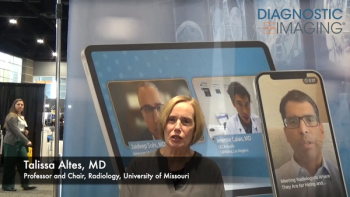
NeuroLogica targets niche for digital imaging in neurology
NeuroLogica wants to fill the gaps left by the surge of new superpremium CTs and advanced SPECT cameras. The 18-month-old imaging company, based in Danvers, MA, has begun building niche products in these two modalities specifically for neurological applications.
NeuroLogica wants to fill the gaps left by the surge of new superpremium CTs and advanced SPECT cameras. The 18-month-old imaging company, based in Danvers, MA, has begun building niche products in these two modalities specifically for neurological applications.
The company's first product, a multislice CT called the CereTom, is designed to improve access to high-quality CT imaging for patients suspected of traumatic brain injury. The compact, ultraportable, and cordless CereTom cleared the FDA in July. The system, which features a 25-cm field-of-view, is designed specifically for head and neck imaging. The scanners are scheduled to start rolling off the assembly line in November.
A second product, slated for commercial release next year, is the NeuroFocus SPECT. This gamma camera, which has not yet been cleared by the FDA, promises improved spatial resolution, according to NeuroLogica president Eric Bailey. In phantom studies, the patented collimators used in NeuroFocus have allowed a resolution of 2 mm.
"We've developed a SPECT that approaches CT and MRI in resolution and has the capacity to see things like small epileptic foci," Bailey said.
NeuroLogica is the brainchild of Bernie Gordon, the founder of Analogic, a $450-million company based in Peabody, MA, that specializes in medical and security imaging. After stepping down last year as chairman of Analogic, Gordon launched NeuroLogica with a team of engineers from Algeria, the Dominican Republic, India, Morocco, and Poland. The company focuses on neuroimaging because this applications area has lagged advancements in neurological treatments, according to Bailey.
Tissue plasminogen activator (tPA), for example, can restore blood flow to ischemic brain tissue, but it is most effective if administered within three hours of symptoms and then only to patients with blocked arteries. It will worsen the condition of patients with hemorrhage.
Prompt identification of blocked cerebral arteries, therefore, is critical to effective treatment. Many hospitals, however, have limited access to CT, and CereTom is intended to address that lack. This product, which will be NeuroLogica's first to reach market, lists for just $250,000. The eight-slice scanner produces spatial resolution on a par with leading high-end CT scanners, Bailey said. With its high-definition pixel data, the CereTom provides sharp 3D surface and volume renderings, as well as multiplanar reconstructions.
Because it is compact (just under 4 feet high and 29 inches wide) and sits on casters, CereTom can be wheeled anywhere in a hospital--to the emergency department or intensive care unit--or it can be mounted in an ambulance. The device does not require x-ray shielding, so it also may be suitable for dental and maxillofacial surgery offices, Bailey said.
The unit is self-contained, equipped with a headboard that can be slid under the patient and a built-in translation mechanism that moves back and forth over the patient's head, thus obviating the eight to 10-foot patient table that commonly accompanies CTs.
Using a wireless image transfer system, CereTom processes images wherever a patient is located and transmits them to a laptop workstation that incorporates advanced software tools, including 3D CT viewing packages from Voxar. The battery-driven unit can scan up to eight patients without recharging, or it can draw power from any standard electrical outlet.
CereTom addresses drawbacks of previous mobile CT scanners such as TomoScan, which was designed by Analogic and sold by Philips Medical Systems. The single-slice TomoScan was too large to move easily to a patient's bedside and had too many wires and cables to use in an interventional or surgical suite, according to Bailey. TomoScan, which is no longer being marketed, also did not produce high-quality images.
Newsletter
Stay at the forefront of radiology with the Diagnostic Imaging newsletter, delivering the latest news, clinical insights, and imaging advancements for today’s radiologists.




























